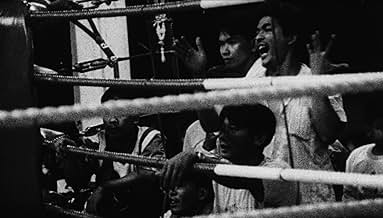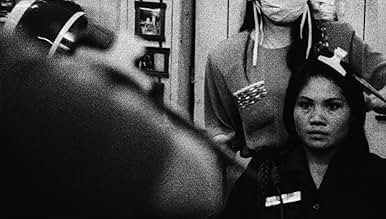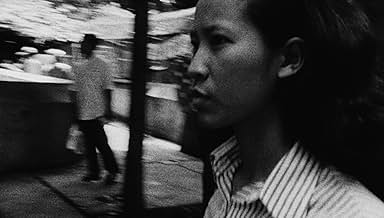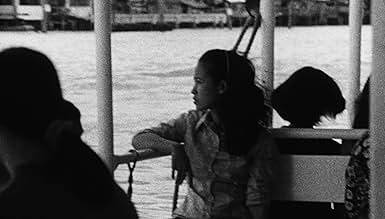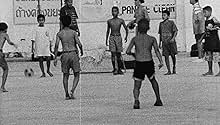VALUTAZIONE IMDb
6,7/10
1844
LA TUA VALUTAZIONE
Aggiungi una trama nella tua linguaA film crew documents a folk story-exquisite corpse combination by random Thai people; the story is reenacted.A film crew documents a folk story-exquisite corpse combination by random Thai people; the story is reenacted.A film crew documents a folk story-exquisite corpse combination by random Thai people; the story is reenacted.
- Premi
- 4 vittorie e 4 candidature totali
Recensioni in evidenza
"Mysterious" held much dramatic promise.
But because of its hybrid innovation, I'm at a lost as to rate it as a dramatic feature or a documentary film. Either way, despite its critical accolades, it wasn't able to interest me enough to wanna cradle its inadequacies. Poor film making craft is inexcusable even if this feature is excusably in a league of its own. (And did anyone catch a moment of Ozu homage in one of the scenes, with children walking by at one end and the camera placed at another? Nice...)
That said, there were undeniable moments of brilliance in it. Two standouts come to mind; The "banter" between the two mute girls and that staged re-enactment by the villagers. And it shown the director to be one who knows how to capture such cinematic sparks, albeit inconsistently.
I thus hope to see "Blissfully yours" before I decide on my regard for Apichatpong Weerasethakul as a film maker. Similarly, "Mysterious" will be given the benefit of the doubt. For honestly, it just didn't hack it for me right now.
But because of its hybrid innovation, I'm at a lost as to rate it as a dramatic feature or a documentary film. Either way, despite its critical accolades, it wasn't able to interest me enough to wanna cradle its inadequacies. Poor film making craft is inexcusable even if this feature is excusably in a league of its own. (And did anyone catch a moment of Ozu homage in one of the scenes, with children walking by at one end and the camera placed at another? Nice...)
That said, there were undeniable moments of brilliance in it. Two standouts come to mind; The "banter" between the two mute girls and that staged re-enactment by the villagers. And it shown the director to be one who knows how to capture such cinematic sparks, albeit inconsistently.
I thus hope to see "Blissfully yours" before I decide on my regard for Apichatpong Weerasethakul as a film maker. Similarly, "Mysterious" will be given the benefit of the doubt. For honestly, it just didn't hack it for me right now.
An interesting film, more for the idea behind it and moments captured than the overall execution.
A filmmaker rolls around town in search of a story, making the film we see. It begins with long footage of driving around Bangkok, then we segue to the story proper with a woman being interviewed, asked about a story.
The story is made-up, the point is not the story of course, but dismantling the conventional telling. Different people are interviewed who bend the story to their fancy, adding stuff. We are not entirely sure who among them are actors coached on what to say, who are passers-by blurting out what comes in their heads. We can tell that some of it was obviously blocked to be filmed, some covertly staged as real and some stolen from glances but the whole is pretty seamless.
This is an opportunity to film all sorts of activities and splice it together to see what kind of sense comes out; among them an amateur theatric production of the story, a simulated TV interview filmed off the TV, (faux?) newsreel footage, real scenes of boxing, a singing contest and sex show, a scene from the film but the camera keeps rolling through the break. When the crippled boy is assigned a random background by one of the interviewees, in the following scene his teacher acquires the same background of war and family loss.
In the West, we have similar films of stories about stories in Saragossa Manuscript and such, where usually the point is structure, hidden meaning and the divination of self.
In the East, specifically Thailand, they have their own traditions of light storytelling and meta-narrative sorting of concepts, both defined by cultural proximity to India. Among the three 'holy' texts of their native Buddhism is a body of work called Abhidharma, teachings about the teachings. Composed after the Buddha's time, commentaries upon commentaries form a complex, layered web of cataloguing various ontological attributes of reality, phenomena and self. Boring if you ever try to read it.
On a historical note, there is evidence that abhidharmic influence in the north of India in turn rippled West through Persia to influence gnostic thought, and East through the Silk Road as both reaction to its scholasticism and elaboration of it contributed to early Chinese Buddhism. In both cases, the distinction is made between mere intellectual reasoning in the abhidharmic vein, and expansive meditative wisdom that looks directly at things. (respectively, gnosis and prajna)
Anyway, the film has no direct link to all that except as pointing to the mesh of meta-narrative.
And it's cool to note that springing from a Buddhist background, in this film of stories about stories the stories are transient, illusory confabulations, there's no intrinsic meaning or symbolism to them, there's no structure beyond co-dependent arising of narrator and image, and the narrator is neither a single self nor on some journey to enlightenment. Nice, if you don't burden yourself with futilely trying to organize the tangle, just directly look at the wondrous nothingness.
The last story is made-up by schoolchildren, collapsing in a fantastical, meaningless heap of witch tigers and magical swords, illusory child's play.
The closing shots are of children kicking a ball, the rush of actual life outside the stories which is the most mysterious object of all.
A filmmaker rolls around town in search of a story, making the film we see. It begins with long footage of driving around Bangkok, then we segue to the story proper with a woman being interviewed, asked about a story.
The story is made-up, the point is not the story of course, but dismantling the conventional telling. Different people are interviewed who bend the story to their fancy, adding stuff. We are not entirely sure who among them are actors coached on what to say, who are passers-by blurting out what comes in their heads. We can tell that some of it was obviously blocked to be filmed, some covertly staged as real and some stolen from glances but the whole is pretty seamless.
This is an opportunity to film all sorts of activities and splice it together to see what kind of sense comes out; among them an amateur theatric production of the story, a simulated TV interview filmed off the TV, (faux?) newsreel footage, real scenes of boxing, a singing contest and sex show, a scene from the film but the camera keeps rolling through the break. When the crippled boy is assigned a random background by one of the interviewees, in the following scene his teacher acquires the same background of war and family loss.
In the West, we have similar films of stories about stories in Saragossa Manuscript and such, where usually the point is structure, hidden meaning and the divination of self.
In the East, specifically Thailand, they have their own traditions of light storytelling and meta-narrative sorting of concepts, both defined by cultural proximity to India. Among the three 'holy' texts of their native Buddhism is a body of work called Abhidharma, teachings about the teachings. Composed after the Buddha's time, commentaries upon commentaries form a complex, layered web of cataloguing various ontological attributes of reality, phenomena and self. Boring if you ever try to read it.
On a historical note, there is evidence that abhidharmic influence in the north of India in turn rippled West through Persia to influence gnostic thought, and East through the Silk Road as both reaction to its scholasticism and elaboration of it contributed to early Chinese Buddhism. In both cases, the distinction is made between mere intellectual reasoning in the abhidharmic vein, and expansive meditative wisdom that looks directly at things. (respectively, gnosis and prajna)
Anyway, the film has no direct link to all that except as pointing to the mesh of meta-narrative.
And it's cool to note that springing from a Buddhist background, in this film of stories about stories the stories are transient, illusory confabulations, there's no intrinsic meaning or symbolism to them, there's no structure beyond co-dependent arising of narrator and image, and the narrator is neither a single self nor on some journey to enlightenment. Nice, if you don't burden yourself with futilely trying to organize the tangle, just directly look at the wondrous nothingness.
The last story is made-up by schoolchildren, collapsing in a fantastical, meaningless heap of witch tigers and magical swords, illusory child's play.
The closing shots are of children kicking a ball, the rush of actual life outside the stories which is the most mysterious object of all.
This approaches art, and does so from an oblique angle and in an exotic locale. That being said for me, it never achieves that art., Despite the loose effort to stitch a thread of a story through this, and some curious disjointed elements, the whole does not hold.
See this film if you are willing to bring a lot to the party. (And kudos to you, davidals@msn.com) Or play it in your rental store, or during a party with the sound off, and it will probably snare more fish than it does standing alone with you and your remote.
I'm all for experimental film, this could have been whittled down to a 7 minute beauty for the Ann Arbor Film Fest; at 83 min, it came across as a chore, a corpse less than exquisite. And while I'm coming across as the anti-hipster, why black (or almost a dusty brown) and white for this film? Color I think would have made this more florid and captivating, although perhaps more common-place and thus undermined the art?
Wait till your film professor assigns this one to you.
3/10
See this film if you are willing to bring a lot to the party. (And kudos to you, davidals@msn.com) Or play it in your rental store, or during a party with the sound off, and it will probably snare more fish than it does standing alone with you and your remote.
I'm all for experimental film, this could have been whittled down to a 7 minute beauty for the Ann Arbor Film Fest; at 83 min, it came across as a chore, a corpse less than exquisite. And while I'm coming across as the anti-hipster, why black (or almost a dusty brown) and white for this film? Color I think would have made this more florid and captivating, although perhaps more common-place and thus undermined the art?
Wait till your film professor assigns this one to you.
3/10
Director Apichatpong Weerasethakul went around Thailand with a film crew for three years, having what seem to be random people tell a round-robin story. One person would tell one part, then on to the next. It's a technique I've seen used in a couple of amateur-press stories from the 1930s, when professional science fiction writers were cheap -- the line was that WONDER STORIES offered a quarter cent per word, payable upon lawsuit. One writer would start the story, another would continue for a few pages, and so forth.
As a story-telling movie, it's .... well, it's an interesting experiment that does not work. The writers in the 1930s round-robin stories were pros, who understood how plotting worked and how far they could veer. With this one, we watch people do a hard left on the story, argue about what has been been decided earlier in the story. It's less like the way in LOVE ME TONIGHT, the song "Isn't It Romantic?" wafts from Paris to a distant castle, changing to various tempi along the way, and more like the way my great-aunt Esther would tell a story. She would drone on for about thirty minutes, pause to make sure I understood some point -- "...so they had to find the money for the rent. If they didn't pay the rent, they could be out on the street, you know what I mean?" After I would tiredly admit that I understood eviction, she would continue with "So once I knew this guy, I think I met him through my friend Rosie from high school, he had a picture of Rutherford B. Hayes on his kitchen wall next to the electric clock." Then she would talk about the clock for half an hour. Not that there was anything interesting about the clock; had there been, I think, she would never have mentioned it at all.
That's what the story-telling in this reminds me of. Oh, the people are trying to tell a good story, but they lack the training.
What I think this movie works as is a city-symphony picture, one of those movies in the 1920s and 1930s which purported to show you Berlin in BERLIN, SYMPHONY OF A GREAT CITY or New York in MANHATTA. I think it works better as that, although it's less about the city and the countryside, their institutions and rhythms, than individuals.
As a story-telling movie, it's .... well, it's an interesting experiment that does not work. The writers in the 1930s round-robin stories were pros, who understood how plotting worked and how far they could veer. With this one, we watch people do a hard left on the story, argue about what has been been decided earlier in the story. It's less like the way in LOVE ME TONIGHT, the song "Isn't It Romantic?" wafts from Paris to a distant castle, changing to various tempi along the way, and more like the way my great-aunt Esther would tell a story. She would drone on for about thirty minutes, pause to make sure I understood some point -- "...so they had to find the money for the rent. If they didn't pay the rent, they could be out on the street, you know what I mean?" After I would tiredly admit that I understood eviction, she would continue with "So once I knew this guy, I think I met him through my friend Rosie from high school, he had a picture of Rutherford B. Hayes on his kitchen wall next to the electric clock." Then she would talk about the clock for half an hour. Not that there was anything interesting about the clock; had there been, I think, she would never have mentioned it at all.
That's what the story-telling in this reminds me of. Oh, the people are trying to tell a good story, but they lack the training.
What I think this movie works as is a city-symphony picture, one of those movies in the 1920s and 1930s which purported to show you Berlin in BERLIN, SYMPHONY OF A GREAT CITY or New York in MANHATTA. I think it works better as that, although it's less about the city and the countryside, their institutions and rhythms, than individuals.
(2000) Mysterious Object at Noon
DOCU DRAMA
Documented by Apichatpong Weerasethakul where he goes around uncovering a myth involving a student on a wheelchair and his teacher "Dogfahr". Filmed in black and white, sometimes the stories are made up while others are being told to and from other people throughout the entire city of Bangkok and Thailand. Viewers are left scratching their heads trying to figure what to make of it as a portion of the docudrama is sometimes off topic. We do not even get to see what is even written about the myth whether Dogfahr was actually dead or alive, or do we even get to visit the site that was supposed to have happened.
Documented by Apichatpong Weerasethakul where he goes around uncovering a myth involving a student on a wheelchair and his teacher "Dogfahr". Filmed in black and white, sometimes the stories are made up while others are being told to and from other people throughout the entire city of Bangkok and Thailand. Viewers are left scratching their heads trying to figure what to make of it as a portion of the docudrama is sometimes off topic. We do not even get to see what is even written about the myth whether Dogfahr was actually dead or alive, or do we even get to visit the site that was supposed to have happened.
Lo sapevi?
- QuizFilming was carried out for three years with a volunteer crew, and only stopped when the camera broke down - the last shot of the movie is literally the last piece of film that passed through the camera.
- ConnessioniFeatured in 40 Days to Learn Film (2020)
I più visti
Accedi per valutare e creare un elenco di titoli salvati per ottenere consigli personalizzati
- How long is Mysterious Object at Noon?Powered by Alexa
Dettagli
- Tempo di esecuzione1 ora 29 minuti
- Colore
- Mix di suoni
- Proporzioni
- 1.37 : 1(original 16mm negative ratio)
Contribuisci a questa pagina
Suggerisci una modifica o aggiungi i contenuti mancanti

Divario superiore
By what name was Dokfa nai meuman (2000) officially released in India in English?
Rispondi

